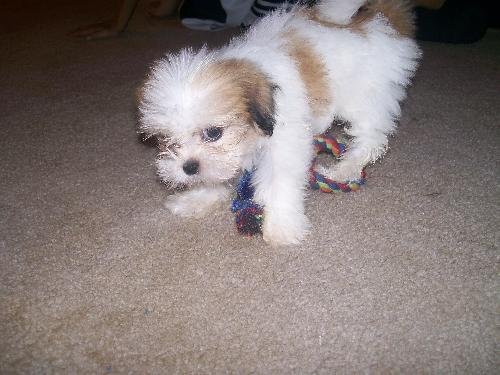Lhasa Apso (medium coat) : : Female : : Small
Learn more about the Lhasa Apso.
| My Rescue |
| Login to Remember your Favorite Animals and Breeds! |
About Fluffy | |
|
|
Fluffy ia tiny lhasa apso puppy. She was returned from the pet store because of grade 2 luxating patellas.
Patellar Luxation (Slipping Kneecap)
by Jennie Bullock
Patellar luxation is the dislocation (slipping) of the patella (kneecap). In dogs the patella is a small bone that shields the front of the stifle joint. This bone is held in place by ligaments. As the knee joint is moved, the patella slides in a grove in the femur. The kneecap may dislocate toward the inside (medial) or outside (lateral) of the leg. This condition may be the result of injury or congenital deformities (present at birth). Patellar luxation can affect either or both legs.
The most common occurrence of luxating patella is the medial presentation in small or miniature dog breeds. Shallow femoral groove, weak ligaments and malalignment of the tendons and muscles that straighten the joint are all conditions that will predispose a dog toward luxating patellas.
Indications of patellar luxation are; difficulty in straightening the knee, pain in the stifle, limping, or the tip of the hock points outward while the toes point inward.
The diagnosis of this condition can usually be confirmed (by a veterinarian) by manipulating the stifle joint and pushing the patella in and out of position.
Patellar luxations fall into several categories:
1) Medial luxation; toy, miniature, and large breeds.
2) Lateral luxation; toy and miniature breeds.
3) Lateral luxation; large and giant breeds.
4) Trauma induced luxation; various breeds
Categories 1, 2, and 3 are either hereditary or strongly suspected of being inheritable.
Beyond the categorization of patellar luxation there are 4 grades of deviation for this condition:
Grade 1:
Intermittent patellar luxation - occasional carrying of the affected limb. The patella can easily be manually luxated at full extension of the stifle, but returns to proper position when pressure is released.
Grade 2:
Frequent patellar luxation - in some cases luxation is more or less permanent. The affected limb is sometimes carried, although the dog may walk with the stifle slightly flexed.
You can't even tell and it certainly doesn't bother her! She is very sweet and funny- she runs all over the house, but likes to be cuddled to. She is really little right now- so no children under 8. Her adoption fee is $275 and she is being fostered in Olmsted Falls. NO APPOINTMENTS WILL BE MADE TO MEET FLUFFY UNTIL AN ONLINE APPLICATION IS RECEIVED BY THE RESCUE AND APPROVED.
Patellar Luxation (Slipping Kneecap)
by Jennie Bullock
Patellar luxation is the dislocation (slipping) of the patella (kneecap). In dogs the patella is a small bone that shields the front of the stifle joint. This bone is held in place by ligaments. As the knee joint is moved, the patella slides in a grove in the femur. The kneecap may dislocate toward the inside (medial) or outside (lateral) of the leg. This condition may be the result of injury or congenital deformities (present at birth). Patellar luxation can affect either or both legs.
The most common occurrence of luxating patella is the medial presentation in small or miniature dog breeds. Shallow femoral groove, weak ligaments and malalignment of the tendons and muscles that straighten the joint are all conditions that will predispose a dog toward luxating patellas.
Indications of patellar luxation are; difficulty in straightening the knee, pain in the stifle, limping, or the tip of the hock points outward while the toes point inward.
The diagnosis of this condition can usually be confirmed (by a veterinarian) by manipulating the stifle joint and pushing the patella in and out of position.
Patellar luxations fall into several categories:
1) Medial luxation; toy, miniature, and large breeds.
2) Lateral luxation; toy and miniature breeds.
3) Lateral luxation; large and giant breeds.
4) Trauma induced luxation; various breeds
Categories 1, 2, and 3 are either hereditary or strongly suspected of being inheritable.
Beyond the categorization of patellar luxation there are 4 grades of deviation for this condition:
Grade 1:
Intermittent patellar luxation - occasional carrying of the affected limb. The patella can easily be manually luxated at full extension of the stifle, but returns to proper position when pressure is released.
Grade 2:
Frequent patellar luxation - in some cases luxation is more or less permanent. The affected limb is sometimes carried, although the dog may walk with the stifle slightly flexed.
You can't even tell and it certainly doesn't bother her! She is very sweet and funny- she runs all over the house, but likes to be cuddled to. She is really little right now- so no children under 8. Her adoption fee is $275 and she is being fostered in Olmsted Falls. NO APPOINTMENTS WILL BE MADE TO MEET FLUFFY UNTIL AN ONLINE APPLICATION IS RECEIVED BY THE RESCUE AND APPROVED.
More about Fluffy
Good with Dogs, Good with Cats, Is Not Good with Kids
Other Pictures of Fluffy (click to see larger version):



